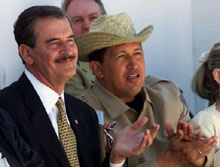 |
 |
 |
 Business News | December 2005 Business News | December 2005  
Venezuela versus Mexico
 Marianna Parraga - ElUniversal.com Marianna Parraga - ElUniversal.com


| | As part of their integrationist crusade, Mexican and Venezuelan rulers have overlapped their intentions. (Reuters) |
Mexico and Venezuela have managed to sneak in as hemispheric energy development poles. The major hydrocarbons producers in Latin America and with an evolved oil business - focused in Pemex and Pdvsa - these two nations try to find a niche in a new marketplace. Both Venezuela and Mexico are highly dependent on the United States in terms of energy, due to proximity. However, while Mexico is consistent with the ideas and projects of the government of President George W. Bush, Venezuela is resolved to redirect oil exports to Southern neighbors and prevent any risks with the North.

As a result, two parallel processes are taking shape. Mexico tries to advance the second stage of Plan Puebla Panama, devised by the government of President Vicente Fox to engage in Central America. Venezuela looks for Mercosur and the Caracas Energy Agreement in order to get closer to Brazil, Argentina, Uruguay and Paraguay. Concomitantly, it has turned into a major supplier to the Caribbean through the new Petrocaribe.

Both strategies are full of announcements about joint refineries - for the express purpose of securing placement of oil; gas pipelines, power interconnections and even service stations. Additionally, regardless of recently deteriorated diplomatic relations, the two nations continue sharing supply of 160,000 bpd to Central America and the Caribbean under the San José Agreement.

As part of their integrationist crusade, Venezuela and Mexico have overlapped their intentions. The hemispheric energy ring proposed by Venezuelan President Hugo Chávez some months ago is just an old plan involving Peru and Ecuador as suppliers of a large gas pipeline. Now, it has been extended to include other nations.

The financial aspect in booming times will eventually define the Venezuelan and Mexican leadership, because most of the nations involved strive to keep a stable economy amidst suffocating oil prices.

Due to technical and funding issues, Mexico, Central America and Colombia agreed during the Meso-American Energy Summit to slow down the pace of integration projects. Such will be reviewed and approved during a summit next May 2006.

Presidents and representatives of the ten member countries of the Central American Integration System (SICA) limited themselves during the Cancun Summit to formalize commitments and set terms, notwithstanding the ambitious Mexican blueprint.

Previously, during the Fourth Summit of the Americas held in the Argentinean resort of Mar del Plata, Mexico had introduced a plan on a refinery, a gas pipeline stretching out 2,600 kilometers from Panama to Mexico, a powerhouse and a gas plant.

Under the Cancun Declaration, an energy reserve fund was also created under the aegis of developed countries. Mexico started already to request contributions from the United States, Canada, Spain and the United Kingdom. The fund will grant credits and budget support to the parties.

Cost of infrastructure is a major inconvenience. Plans total USD 9 billion, including at least USD 3.1 billion for the refinery contended by Costa Rica, Guatemala and Panama, and fed by Mexico.

"We were overexcited. From the initiative in Mar del Plata to the meeting in Nicaragua, calculations were really made," Nicaraguan Trade Vice-Minister Manuel Paredes explained.

The initial Mexican proposal included a contribution of 40 percent out of the total amount, in addition to 40 percent from Central America and the remainder from the private sector. Even in this case, some nations cannot afford the outlay.

Nor was the range of fuels used in the hemisphere taken into account. However, the nations concerned are certain that before the end of 2006 there will be a bidding for the facilities needed. Afterwards, four years will elapse before commissioning.

Translated by Conchita Delgado | 
 | |
 |



